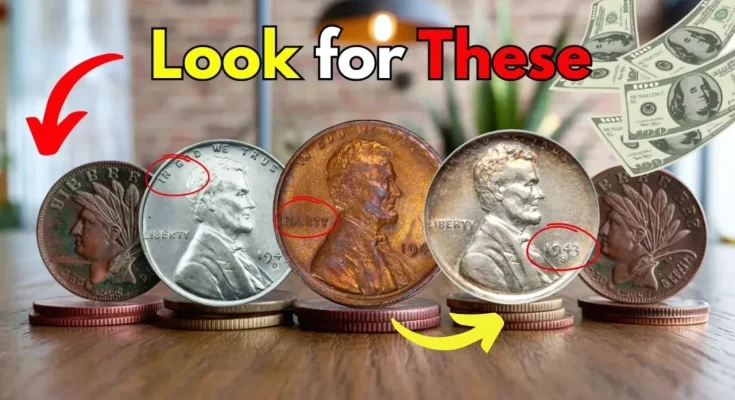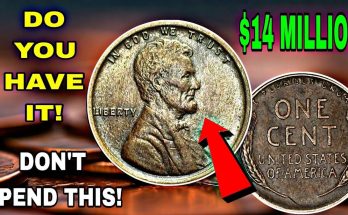In the world of coin collecting, the smallest denominations sometimes hold the greatest value. Steel wheat pennies, particularly those minted during the 1940s, are a prime example of how rare errors and historic circumstances can turn ordinary coins into prized possessions. While most wheat pennies are worth only slightly more than their face value, a select few can command prices in the hundreds of thousands or even millions.
The introduction of steel into penny production was a temporary wartime measure. In 1943, the U.S. Mint shifted from copper to zinc-coated steel due to the military’s increased need for copper. While the intent was clear and well-documented, unintentional errors during this transition gave rise to some of the rarest coins in U.S. history. A handful of these steel wheat pennies were struck in bronze, while others appeared in steel during years when copper had been reintroduced.
These coins are not only valuable due to their limited mintage but also because of their historical relevance. They serve as physical evidence of how American industry and minting processes adapted during wartime, and how even small oversights resulted in collectibles of immense financial value. The five coins discussed below are examples of such exceptions—each one having fetched extraordinary prices in private sales or at auction.
The 1943 Bronze Wheat Penny
One of the most valuable pennies ever produced by the U.S. Mint is the 1943 bronze wheat penny. As copper was redirected for military use during World War II, the mint transitioned to steel coin blanks coated in zinc. Despite this change, a small number of bronze planchets from 1942 were accidentally left in the minting machines and were used to strike 1943-dated coins.
Experts estimate that between 10 to 20 genuine 1943 bronze pennies exist today. These coins typically weigh about 3.11 grams, heavier than their steel counterparts and do not stick to magnets. They were distributed through normal channels and only discovered years later by collectors and dealers who recognized their uniqueness. Their composition error makes them extremely rare and highly valuable.
In 2010, one such coin was sold for an astonishing $1.7 million in a public auction. This set a record for Lincoln cents and established the 1943 bronze penny as one of the most lucrative American coins to ever reach the market. Because of the extreme rarity and demand, counterfeit versions exist, making authentication by certified grading services essential.
The 1944 Steel Wheat Penny
As copper returned to circulation in 1944, the mint officially stopped producing steel pennies. However, a few steel blanks from 1943 remained and were used to mint 1944 coins, resulting in the rare and highly valuable 1944 steel penny. These coins are the inverse of the 1943 bronze error and equally coveted by collectors.
Approximately 30 to 40 authenticated examples are known to exist, and all are characterized by their magnetic properties, silvery appearance, and slightly lighter weight, typically around 2.7 grams. The presence of this coin is attributed to leftover materials that were unintentionally used during the transition back to copper.
A high-quality specimen of a 1944 steel penny can be worth between $75,000 and $500,000, depending on its condition, mint mark, and overall grade. These coins have sold at major numismatic auctions and are often held in institutional or private collections.
The 1943-D Bronze Wheat Penny
Among the rarest of Lincoln cents is the 1943-D bronze penny, struck at the Denver Mint. This coin carries both the bronze composition error and a mint mark that sets it apart. While most of the 1943 bronze pennies were struck in Philadelphia, only a few were produced in Denver, making this version even more elusive.
Estimates suggest that fewer than five authentic examples of the 1943-D bronze penny exist. One such coin made headlines when it was privately sold for approximately $1.7 million. The combination of limited quantity, mint mark distinction, and wartime origin contributes to the high valuation of this penny.
The coin’s authenticity must be verified through metallurgical analysis and third-party grading, particularly due to its history of counterfeiting. The unique blend of circumstances that led to this coin’s existence makes it one of the most sought-after pieces in U.S. numismatics.
The 1943-S Bronze Wheat Penny
San Francisco also inadvertently struck a small number of bronze pennies in 1943. These 1943-S bronze wheat pennies are visually similar to the Philadelphia and Denver versions but bear the distinguishing “S” mint mark. Their rarity and clear documentation of origin make them high-value collector items.
Fewer than ten 1943-S bronze pennies have been confirmed. When offered for sale, they frequently exceed estimates, with known transactions approaching the $1 million mark. Their value fluctuates depending on condition, grade, and auction setting, but the coin’s rarity remains undisputed.
The combination of a correct design struck on the wrong metal during a period of material shortages underscores the historical significance of this error. As with all rare pennies, authentication is crucial and should only be done through certified numismatic channels.
The 1943 Double Die Steel Penny
Unlike the others on this list, the 1943 double die penny is not rare because of the metal used, but due to a mechanical flaw during the minting process. A misalignment in the dies used to strike the coin resulted in a clear doubling of the date, lettering, or motto on some 1943 steel pennies.
These double die errors are identifiable to the naked eye and highly appealing to collectors because of their visual uniqueness. While not as rare as the bronze composition errors, the most well-preserved double die steel pennies can sell for $10,000 to $100,000, depending on grade and clarity of the doubling.
Since the minting process in 1943 involved massive production volumes, a small error like this was likely overlooked during quality checks. Today, these coins serve as reminders of the pressure the mints operated under during wartime.
Characteristics of the Rarest Steel and Bronze Pennies
The following table summarizes important identifying features, material composition, estimated values, and the number of known examples for each of the five rare coins discussed:
| Coin Type | Mint Year | Mint Mark | Composition | Estimated Value | Known Examples |
|---|---|---|---|---|---|
| 1943 Bronze Wheat Penny | 1943 | None | Bronze (Copper) | Up to $1.7 million | 10–20 |
| 1944 Steel Wheat Penny | 1944 | All Mints | Steel (Zinc-Coated) | $75,000–$500,000 | 30–40 |
| 1943-D Bronze Wheat Penny | 1943 | D (Denver) | Bronze (Copper) | $800,000–$1.5 million | Less than 5 |
| 1943-S Bronze Wheat Penny | 1943 | S (San Francisco) | Bronze (Copper) | $500,000–$1 million | Under 10 |
| 1943 Double Die Steel Penny | 1943 | All Mints | Steel (Zinc-Coated) | $10,000–$100,000 | Dozens |
How to Identify a Rare Wheat Penny
Anyone interested in verifying the authenticity of a potential rare penny should begin with basic tests that can be conducted at home. Though not definitive on their own, these tests can help narrow down whether a coin warrants further professional evaluation.
Check Magnetic Properties
- Steel pennies are magnetic. Bronze or copper coins are not.
- If a 1943 penny does not stick to a magnet, it could be bronze, a possible error.
Weigh the Coin
- Bronze coins weigh around 3.11 grams.
- Steel pennies typically weigh 2.7 grams.
- A digital gram scale can help quickly identify outliers.
If the coin passes both of these tests, it’s advisable to consult a reputable coin grading service such as PCGS or NGC. These organizations can verify the coin’s authenticity, assign a grade, and encapsulate it in a protective holder for preservation.
Considerations for Collectors and Sellers
Understanding what drives value in rare coins is essential for both collectors and potential sellers. Several factors must be taken into account before a final valuation can be made.
- Grade and Condition: Coins in mint or near-mint condition typically command significantly higher prices.
- Authentication: Without certification from a recognized grading authority, rare coins may be treated with skepticism by buyers.
- Provenance: Coins with a traceable history, especially those sold through known auction houses, often perform better on the secondary market.
- Market Trends: Coin values fluctuate based on overall demand, economic conditions, and collector interest in specific mint errors.
Major factors that influence pricing and sale potential for rare wheat pennies:
| Factor | Impact on Value | Notes |
|---|---|---|
| Physical Condition | High | MS65+ coins command premium pricing |
| Rarity | Very High | Fewer known examples significantly increase value |
| Mint Mark | Moderate to High | D and S mint marks often increase demand |
| Authentication | Essential | Professional grading ensures credibility |
| Market Timing | Variable | Prices can spike during numismatic booms |
Steel wheat pennies from the World War II era serve as powerful examples of how minor minting errors and material shifts can result in incredible value decades later. While most pennies are still worth only a cent, those discussed in this article have sold for tens of thousands to over a million dollars in verified transactions. The presence of these coins in the hands of the public, sometimes unknown and unrecognized for years, makes them especially fascinating.
Whether inherited through a family collection or found in a forgotten jar, a single rare penny could represent a life-changing opportunity. With careful examination and the right knowledge, anyone can take the first steps toward identifying these valuable coins and potentially joining the ranks of millionaire collectors.



